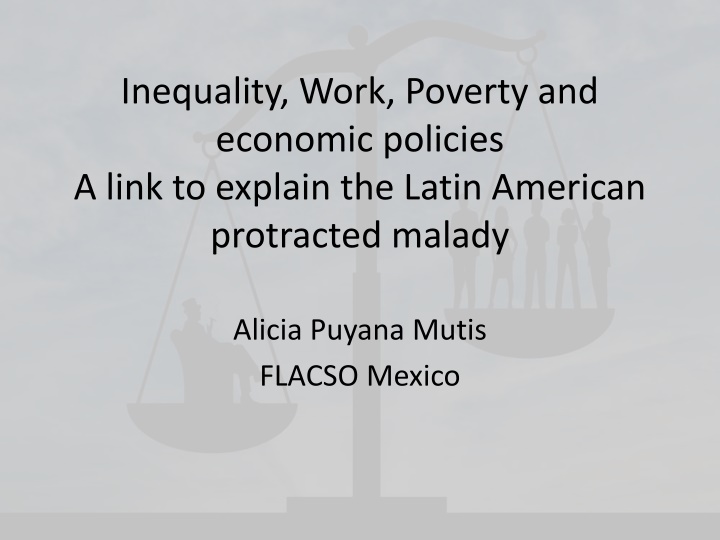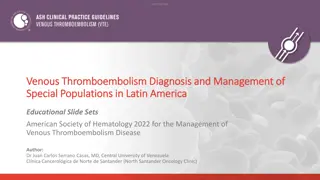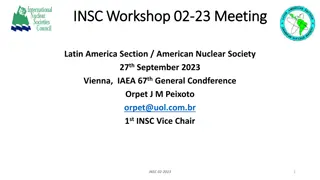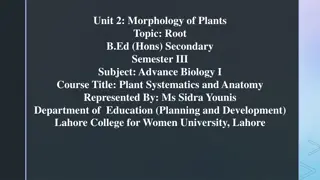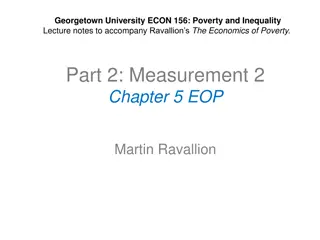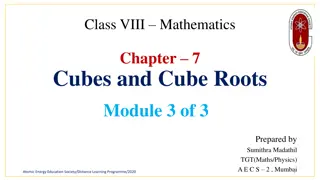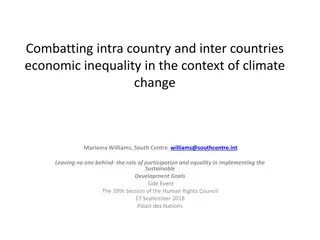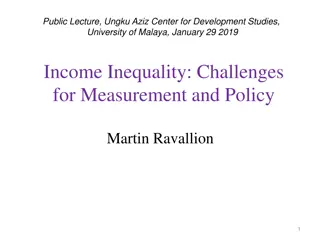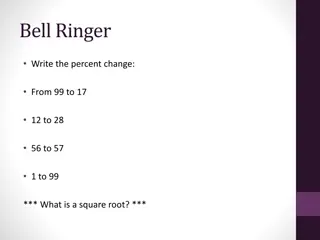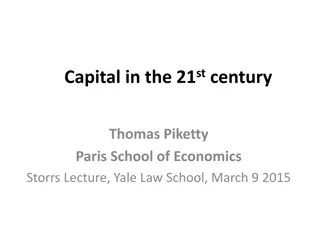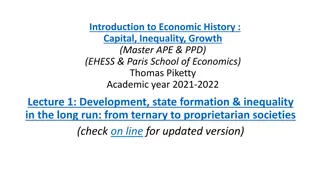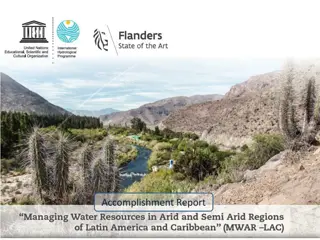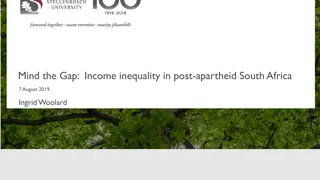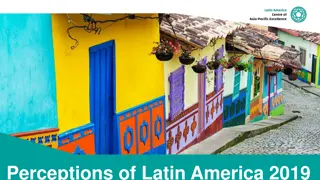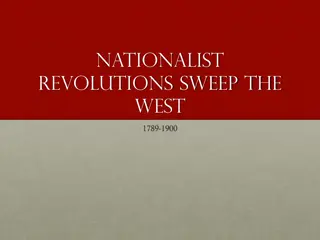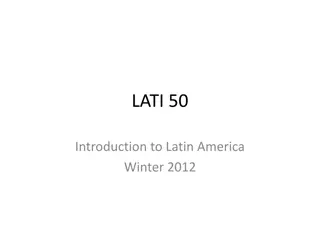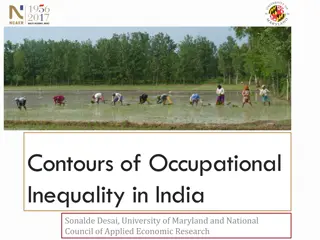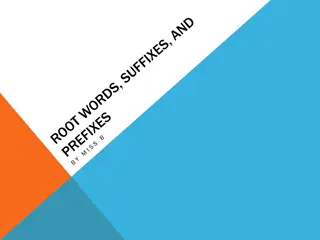Latin American Inequality: Historical Roots and Modern Implications
Latin American inequality is deeply rooted in historical economic and political structures, impacting poverty and work conditions. The link between economic concentration, political power, and social injustices has perpetuated this protracted malady. Understanding the evolution of income distribution and wealth concentration sheds light on the challenges faced in the region. Amidst evolving economic policies and societal norms, the discourse on poverty and inequality remains crucial for addressing systemic issues.
Download Presentation

Please find below an Image/Link to download the presentation.
The content on the website is provided AS IS for your information and personal use only. It may not be sold, licensed, or shared on other websites without obtaining consent from the author.If you encounter any issues during the download, it is possible that the publisher has removed the file from their server.
You are allowed to download the files provided on this website for personal or commercial use, subject to the condition that they are used lawfully. All files are the property of their respective owners.
The content on the website is provided AS IS for your information and personal use only. It may not be sold, licensed, or shared on other websites without obtaining consent from the author.
E N D
Presentation Transcript
Inequality, Work, Poverty and economic policies A link to explain the Latin American protracted malady Alicia Puyana Mutis FLACSO Mexico
A dash of history The history of Latin American inequality shows: a) The link between economic concentration and pol tica power b) The prevalence in the long run of inequality with changes emanating from political transformtions. c) Income concentration in a century and a half has evolved around a 0.54 Gini d) Land property and economic growth and specialization centered in concentrated resources reproduce economic, social en political divergences
A dash of history Inequality is a topic that comes and goes depending on political and social circumstances. In modern economics , the treatment of inequality and poverty have evolved concentrated on individual s income. For classic economists inequality and poverty affect individuals morally and socially (Smith & Ricardo) and fracture the social fabric. If the majority of its members live in poverty there is no basis for mutual respect (as noted by Humboldt in Mexico) Wages are social arrangements between a handful capitalist and numerous workers
The roots of poverty and inequality In Smith, a person is rich or poor, depending on the amount of labor they needs to offer or can buy. because of the causality between poverty (lack of resources) and inequality (lack of opportunities) there is the need to considered together So the divide emerges from the property of means of production and the uneven bargain capacity between the very many workers and the very few capitalist Governments enacted then and now, laws and norms discriminating against labor to reduce the its compensation at the lowest possible and socially acceptable level .
A misleading analisis By focusing in income rather in wealth concentration economic theory obscured the roost of inequality, let it be income, wage, education, health and hides the primary distribution of income. By taking the effects as causes of inequality acts on the former leaving the latter intact. The 2008 crisis demonstrated the direct relationship between concentration of wealth and political power and that the market does not allocate resources efficiently
Inequality in New Spain Circa 1770 Average Annual income in Mexican Pesos In relation to the Media 6.12 1.14 0.24 1 Percentage of population Per family 1,543 300 61 252 Per capita 309 Spanish upper class Mestizo middle class Indigenous peasant TOTAL* 10 18 72 100 60 12.2 50.4 Source: Milanovic et al (2007) Milanovic, Branko, Lindert, P. Williamson, G. (2007) MEASURING ANCIENT INEQUALITY , NBER Paper 13550, downloaded from: http://www.nber.org/papers/w13550. Milanovic elaborated the averages from: Humboldt, A. V (1822) Ensayo pol tico sobre el reino de la Nueva Espa a , en: https://archive.org/details/bub_gb_D5Fla3_P_h8C
Chile, index of income concentration 1850-2009 65 60 55 50 45 40 1850 1854 1858 1862 1866 1870 1874 1878 1882 1886 1890 1894 1898 1902 1906 1910 1914 1918 1922 1926 1930 1934 1938 1942 1946 1950 1954 1958 1962 1966 1970 1974 1978 1982 1986 1990 1994 1998 2002 2006 The changes in the concentration of inocme coincde with changes in political regimes: the Reductions when socially oriented political forces took power and the increases with the arrival of the opposite forces. We see this oscilations today in Argentina, Brazil, Ecuador And decades before in Peru and Mexico.
From the colonial times up to day: The extreme concentration of land AVERAGES 1966-70 1971-75 1976-80 1981-85 1986-90 Far East Gini Tierra Gini Ingreso 0.56 37.26 0.56 38.89 0.56 38.53 56.00 38.60 56.00 40.04 Latin America Gini Tierra Gini Ingreso 0.81 57.24 0.81 50.93 0.81 49.77 81.00 49.06 81.00 50.16 North Africa and Middle East Gini Tierra Gini Ingreso 0.67 43.67 0.67 41.65 0.67 41.90 67.00 42.95 67.00 38.17 North America Gini Tierra Gini Ingreso 0.64 35.61 0.64 35.28 0.64 35.91 64.00 35.12 64.00 36.54 South asia Gini Tierra Gini Ingreso 0.56 33.30 0.56 33.32 0.56 35.37 56.00 36.68 56.00 33.57 Africa Subsaharian Gini Tierra Gini Ingreso 0.61 39.00 0.61 0.61 44.00 61.00 41.21 61.00 35.75 East Europe Gini Tierra Gini Ingreso 0.57 37.09 0.57 34.88 0.57 30.82 57.00 29.74 57.00 30.83 Total Gini Tierra Gini Ingreso 0.65 40.63 0.65 39.32 0.65 38.51 65.00 36.91 65.00 38.58
Gini index of income concentration in Latin American Countries 1960-2014
Functional distribution of income in selected countries, share of payments to labor as percentage of GDP 1970-2014 1970 1980 1990 2000 50,1 57,0 45,4 39,8 32,8 29,7 2010 50,4 53,3 41,6 36,1 32,7 27,6 2011 49,9 53,3 42,2 37,0 31,4 27,0 2012 50,7 53,3 42,8 38,7 32,2 27,1 2013 50,7 53,0 43,2 39,4 32,7 27,5 2014 50,3 53,3 43,5 39,2 33,1 27,1 2014-1970 -2,9 -4,8 9,3 -3,5 -5,9 -8,5 Canada United Estates Brazil Chile Colombia Mexico 53,2 58,1 34,2 42,7 39,0 35,7 53,3 56,8 34,7 38,1 41,6 36,0 53,4 55,9 45,4 33,8 37,4 29,5
Conclusions Latin American inequality is deeply rooted in the colonial period and the changes in income concentration seem to be marginal, temporal and induced by changes in political regimes. The concentration of land property and the specialization in commodities are the main causes of the protracted Latin American inequality. Such intense fragmentation is destructive inhibits growth and investments The international specialization in commodities and maquila final consumption manufactured goods has induced an economic model intensive in imports low growth, stagnating productivity and incomes Concentration of wealth is the central element determining the functional distribution of income in which a fast deterioration of the labor retribution has intensified since the structural reforms initiated in mid 1980s
